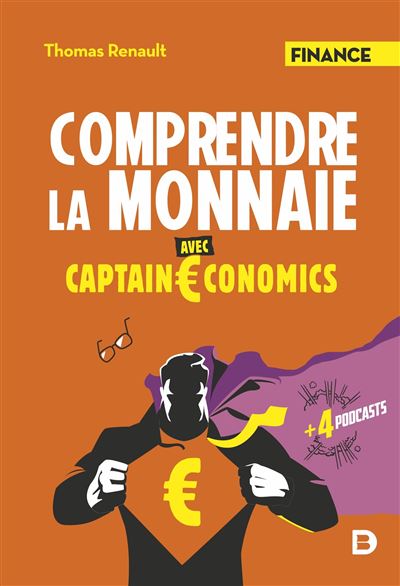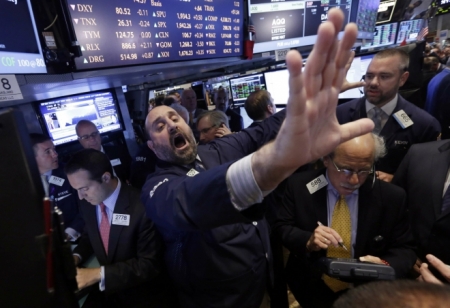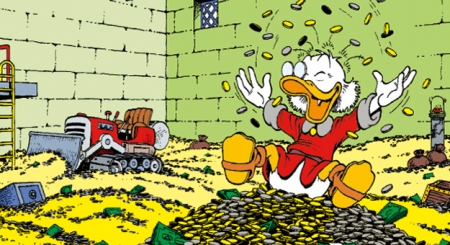Is the euro overvalued? And should the European Central Bank intervene on the markets to devalue the euro in order to improve the competitiveness of the countries of the euro zone? This current debate opposes countries of Southern Europe (led by France) to countries of Northern Europe (led by Germany and accompanied by the ECB). The core issue is in fact pretty easy to understand: the European producers who export to countries that do not belong to the euro zone should benefit from a devaluation of the euro and increase their competitiveness, which in fine should revive the European industry. Then, why are some countries opposed to this idea?
The answer lies on what we call ‘imported inflation’: a devaluation of the euro would increase the price of imports from countries that do not belong to the Euro zone. For instance, when the Euro depreciates against the Dollar, the French firms that export to the US can gain some market shares, but at the same time the price of gas increases in France. The key here is therefore to take into account both positive AND negative aspects of a devaluation of the Euro for the various countries of the Euro zone in order to measure the overall impact on the competitiveness and the GDP of the Euro zone.
Talking about the issue of a “strong Euro” often goes together with a nasty habit that consists in focusing on the Euro-Dollar exchange rate only to evaluate the competitiveness of the euro zone. It is true that the United States are an important trade partner of the Euro zone; however, only 12.07 % of all exports to countries outside the Euro zone (those that can be impacted by a devaluation) are exports to the US (average on the period 2007-2011; source: "ECB External Trade").
In order to evaluate properly the level of the Euro, it is then important not to look at the level of the Euro-Dollar rate only (a ‘bilateral exchange rate’ that gives a rather incomplete vision of the situation) but to focus instead on the ‘effective exchange rate’ (henceforth EER). According the definition of the INSEE, the effective exchange rate is the exchange rate of a monetary zone measured as a weighted sum of exchange rates with various trade partners and competitors. The weighting corresponds to the importance of each trade partner outside of the monetary zone regarding the level of trade (imports and exports) of goods and services made with this partner. This way the European Central Bank calculates a weight for each partner country in order to evaluate the level and variations of the value of the Euro no more relative to the Dollar only, but also relative to a weighted average of the currencies of the main trade partners of the Euro zone (the higher the weight, the more the country trades with the Euro zone). Thus the “EER-20” corresponds to the nominal Effective Exchange Rate that takes into account the 20 most important trade partners of the Euro zone. The weights of each of these partners are the following (the ‘EER-40’ can also be found on the ECB website, with among other trade partners Russia, Turkey, India and Brazil that have a relatively high weight):
Trade weights used in the calculation of the EER-20 on the period 2007-2009

It is true that the bilateral Euro-Dollar exchange rate is important, though, due to the fact that some countries manage their exchange rate depending on the US Dollar and the fact that the goods traded with some countries are labelled in Dollars (and not in Euro or the domestic currencies of these countries). But to consider this parity only and conclude that “the Euro is too strong” (what is often made by the media or by politicians) is a bit of a leap. Indeed, a careful look at the exports of countries of the Euro zone to countries that do not belong to the Euro zone shows that the share of trade with the exports to the US account for about the same as the exports to the quartet Poland-Sweden-Korea-Canada. And yet, we seldom hear anything about the Euro-Zloty, Euro-Krona, Euro-Won or Euro-Canadian dollar exchange rates (relative to the Polish, Swedish, South Korean and Canadian currencies, respectively).
On the ECB website, the nominal effective exchange rate is calculated every day (source "Daily nominal effective exchange rate of the euro"). On the graph below, we can notice a strong appreciation of the Euro against the weighted average of the other currencies since the summer 2012, meaning approximately since when Mario Draghi reassured the markets with his much vaunted "within our mandate, the ECB is ready to do whatever it takes to preserve the Euro. And believe me, it will be enough." But if you compare the actual level to the historical pre-crisis levels, the Euro is actually far below its level of 2007/2009 (and it is also true if you look at the Euro Dollar parity only, which is actually in the bottom half of the past 5-6 years).
Nominal effective exchange rate of the euro

To get a closer look at competitiveness (the core of the actual debate), it is incidentally better to look at the ‘Real Effective Exchange Rate’ that takes into account the weighted average of the currencies of the main trade partners adjusted by the inflation differential. It is a bit too technical to explain, but here is what the ECB tells about it:

In an article published today and entitled “Stop fantasizing about a weaker Euro” (“Il faut arrêter de fantasmer sur la baisse de l’Euro”, CIB Natixis, 11 Feb. 2013), Patrick Artus incidentally uses this real effective exchange rate on the GDP of the Euro zone to show that in the past, no impact of variations of the exchange rate on the GDP of the Euro zone has ever been observed. As the Euro has, all the same, varied a lot since its creation (very low level in the beginning, strong appreciation at the beginning of the 2000’s, a peak mid-2008 and a strong depreciation then with the sovereign debt crisis), it does not seem that there is any clear relationship between the level of the Euro and the total GDP of the Euro zone in volume (see the graph).
Graph 2a - Euro zone: GDP in volume and real effective exchange rate (Annual Growth in %)

In order to identify more precisely the impact of devaluing the Euro on the total GDP of the Euro zone, it is important to take into account what we call the elasticity of exports and imports of the Euro zone towards the exchange rate. Elasticity? To keep it simple, it consists in having a look at how the volumes of imports and exports vary when the currency depreciates. If the elasticity is low (close to zero in absolute value), it means that if the Euro loses some of its value, then the exports in volume will increase by a smaller proportion (very slightly). In this case, the “positive” effect of an increase in exports will be low, and the “negative” effect of the simultaneous increase in price of the imports will probably be higher. This depreciation will consequently lead to a loss for the Euro zone.
According to this study, the elasticities towards the exchange rate in the Euro zone are low (relatively close to zero) and so (I quote), “considering the volume of exports and imports and the elasticities [in the Euro zone], the price effect of imports prevails over the volume effect of exports and imports”. Then “a depreciation of the Euro reduces the GDP in volume”. The conclusion of Patrick Artus is eventually very simple: “we may be better forget the depreciation of the Euro as a tool to exit the crisis of the Euro zone”.
Conclusion: As an answer to the accusation of a “too strong Euro” formulated by Moscovici and Arnaud Montebourg, the spokesperson of Angela Merkel answered a few days ago that a targeted devaluation would allow obtaining impulses on the short term only, and that it could not ensure any long-term reinforcement of competitiveness. He also added that “if you look at the historical context, the German government considers that the Euro is not currently overvalued”. On this aspect, the Captain’ joins the enemy and moves to the Germans’ side! It does not mean, however, that the ECB has no role to play in case of a currency war that could impact the stability of the euro zone… But currently the Captain’ feels that the Euro is used as a scapegoat to justify the loss in competitiveness in France and the Southern countries while the real problem is to be found somewhere else (lack of reforms, no common project on the long-term, non-optimal monetary zone, standard of living higher than what we could afford for many years …)!
 Cet article est mis à disposition selon les termes de la licence Creative Commons Attribution - Pas de Modification 4.0 International. N'hésitez donc surtout pas à le voler pour le republier en ligne ou sur papier.
Cet article est mis à disposition selon les termes de la licence Creative Commons Attribution - Pas de Modification 4.0 International. N'hésitez donc surtout pas à le voler pour le republier en ligne ou sur papier.








